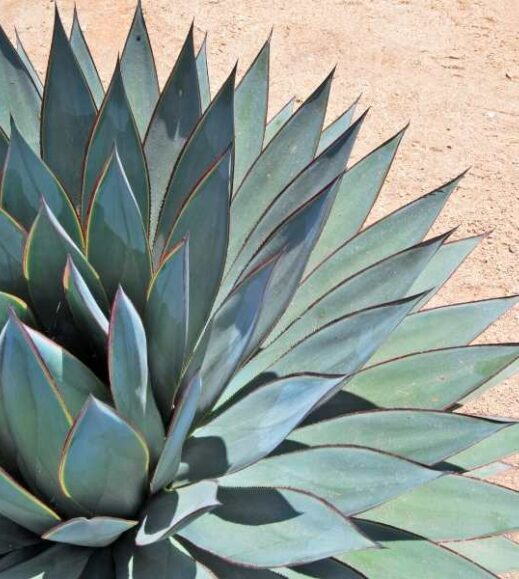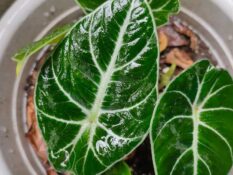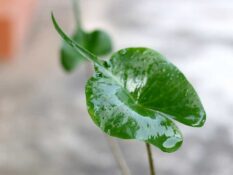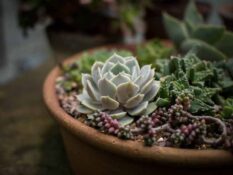Propagate | Soil | Light | Water | Temperature | Humidity | Potting | Pruning | Fertilize | Pest Control | FAQs
Agave is a plant native to the semi-arid regions of North America, primarily Mexico and parts of the Southwestern United States. Native Americans have used it for centuries as a source of food, fiber, and medicine. Agave plants are also Century Plants because they can grow up to 20 feet tall in just one season!
Agave plants are distinctive and unique, with many interesting characteristics that make them a great addition to any garden. They have thick, waxy leaves that help retain water during drought, making them ideal for dry climates or areas with little rainfall. Agave plants also have large rosettes of spiny leaves that can reach up to 8 feet in length. The sap from agaves is often made into tequila or mezcal liquor, which is why some people refer to them as "tequila plants." Additionally, they are slow-growing but long-lived and can grow up to 20 feet tall in one season!
This guide will answer most of the questions and concerns about growing and caring for Agave plants.
Do agave flower? What color is the agave flower?
Yes, agave plants can flower and produce beautiful clusters of yellow or orange flowers at the top of their rosette. The color of the flowers depends on the type of agave plant - some varieties have dark-colored petals, while others have vibrant yellow or orange blossoms. Flowering typically occurs once every 5 to 15 years, depending on the variety.
When to plant agave plant?
The best time to plant an agave plant is an early spring or after the last frost. To plant an agave plant, you should dig a hole with the same depth as your plant's root ball and at least twice as wide. Carefully place the agave plant in the hole, ensuring all roots are covered. Then, backfill with soil and tamp down firmly to secure the plant. Water your agave plant regularly to keep the soil moist and help it get established.
Types of agave: what are the recommended varieties of agave plants?
There are many different agave plants, each with unique characteristics and care requirements. Some popular varieties include Blue Agave, Century Plant, and Foxtail Agave.
Blue Agave: Blue Agave is one of the most widely grown varieties and is best suited for hot, dry climates. It is a fast-growing plant with long, spiky leaves and tall spikes of yellow flowers.
Century Plant: Century Plant is another popular variety with long, grey-green leaves and yellow flowers. It grows best in full sun and prefers dry, sandy soil.
Foxtail Agave. Foxtail Agave is a smaller variety with long, thin leaves and bright yellow flowers. This plant tolerates colder temperatures and grows well in partial shade.
No matter which type of agave plant you choose, providing the right conditions for optimal growth and health is important.
Agave soil requirements: What is the best soil for agave plants?
Agave plants require well-draining soil that is rich in organic matter. Ideally, the soil should be slightly alkaline with a pH between 7.0 and 8.0.
To prepare the soil, you should add plenty of compost or well-rotted manure to improve drainage and fertility. You can also add an organic mulch, such as wood chips or straw, to help retain soil moisture and suppress weeds.
Use healthy soil that is free of disease. Adding amendments and enhancers to the soil can help improve plant growth.
Agave light requirements: How much light does agave plant need?
Agave plants prefer full sun, although they can tolerate some partial shade. They should be planted in an area with at least 6 hours of direct sunlight daily.
If your agave plant is planted in a shaded area, it will grow more slowly and may flower less often. It is also important to avoid placing your agave plant in a site with heavy, damp shade, or it will be more susceptible to disease.
If you're looking to help your plants grow better under low light conditions, using plant grow light designed for specific plant wavelengths can improve growth.
Agave water requirements: How often to water the agave plant?
Agave plants are drought-tolerant and can survive long periods without water. However, to ensure optimal growth and flowering, it is important to provide regular water to your plant.
To water your agave plant, apply a deep soaking once or twice a week rather than a light watering daily. If the soil is dry down to a depth of 3 inches, it's time for another watering.
Remember that the soil around your agave plant may dry out faster than the rest of your garden, especially in hot, dry conditions. If you notice that your agave plant is wilting, it may be a sign of drought stress and will likely benefit from extra watering.
The frequency at which you need to water your plants depend on the season and specific environment. To water your plants most effectively, choose an irrigation system that suits their needs.
Agave temperature range: What temperature can agave tolerate?
Agave plants prefer hot, dry conditions and can tolerate temperatures up to 100 degrees F. However, they should be planted in a protected site from harsh winds and direct sunlight.
To help your agave plant thrive, providing some shade during the midday heat is a good idea. You can do this by planting it in a location with other plants, such as shrubs or hedges.
If your agave plant is subjected to hot, dry conditions for extended periods, it will likely experience leaf loss and die back. In this case, it is important to provide the plant with proper care and ensure it gets enough water and nutrients.
Protect plants during bad weather by using greenhouse, cold frame, and plant protective covers which help to to create a protected environment for your plant.
Agave humidity: Do agave plants like humidity?
Agave plants are somewhat drought-tolerant and do not require high levels of humidity. However, they may benefit from increased humidity in extreme heat or drought conditions.
One way to increase humidity around your plant is to place it in an area with other plants, such as shrubs or hedges. This will help create a more humid microclimate and provides better protection from extreme weather.
If you're looking for other ways to increase humidity, try installing a misting or drip irrigation system. You can also install fans to help circulate moist air around your plant.
Whatever method you choose, monitor the humidity levels near your agave plant and adjust as needed. This will help ensure that your plant has the ideal growing conditions.
Several products help to maintain the humidity of plants around your agave, including plant misters, plant pots with built-in reservoirs, and even grow lights that help provide a source of moisture. Please choose the best product for your plants and their needs.
Where to plant agave plant?
Agave plants can be found at many garden centers or online. Look for plants that are healthy and free of pests or diseases. Always look over the roots before purchasing your plant,avoid any signs of rot or decay. You can research to find reputable sellers with high-quality planting materials beforehand.
Agave plant propagation: How to propagate agave plant?
Propagating plants is the creating new plants from existing ones. Several methods can be used to propagate agave plants, including stem cuttings, division, and seeds.
Propagate agave plant from seed
Agave seeds can be sown directly in the ground once collected. If you want to start your seeds indoors, it's best to do so in late fall or early winter.
To start:
- Fill a seedling flat with potting soil and sprinkle your seeds.
- Cover the seeds with a thin layer of soil and water gently.
- Place your seedling flat in a warm, sunny location and keep it well-watered.
Once the seeds germinate, you can transplant them to a larger pot or directly into the soil in your garden. You should provide plenty of water and nutrients as your plants grow.
If you're looking for other ways to propagate your agave plant, consider taking stem cuttings from the tips of your plant. This is a great way to produce new plants while maintaining your original.
Propagating agave plant by cutting
Agave plants can also be propagated by cutting. To do this, choose a healthy stem from the center of the plant and remove it with a sharp, clean knife. Cut at an angle, leaving a few inches of stem on the parent plant.
Once you've cut your stem, place it into a pot filled with well-draining soil. Keep your plant in a warm, sunny location and water consistently. You should see new roots and shoots growing from the stem in a few weeks.
As your plant grows, provide ample nutrients and water to help it thrive. You can also transplant your new agave plant into the soil in your garden or continue growing it indoors. With a little care and patience, you'll be able to propagate your agave plants in no time!
Propagating agave plant by division
Agave plants can also be propagated by division. To do this, choose a healthy stem from the center of your plant and remove it using a sharp, clean knife. Next, you'll want to carefully divide the plant into smaller sections using a clean pair of gardening shears.
Once you've divided your plant, keep the smaller sections moist and in a warm, sunny location. You should see new roots and shoots growing from the cuttings in a few weeks.
As your plant grows, provide ample nutrients and water to help it thrive. You can also transplant your new agave plant into the soil in your garden or continue growing it indoors.
When done properly, these methods of propagating Agave plants are effective and quick ways to produce new plants from old ones. Choose the right time of year, and start with good quality and healthy planting materials.
Potting agave plant
Thanks to their beautiful appearance and hardy nature, agave plants are popular with gardeners and outdoor enthusiasts. If you're looking to start your agave plant, one of the best ways is to pot the plant in a container.
To get started, you'll want to choose a large pot to accommodate your agave's size and root system. Could you make sure you choose a healthy, young plant with bright green leaves and plenty of new growth?
Once you've picked a pot, fill it with a well-draining potting mix, then plant your agave in the center. Water the plant thoroughly and place it in a warm, sunny location. Be sure to water regularly, especially during the hotter months of the year.
As your agave plant grows, you'll be able to prune and shape it as needed. For the best results, fertilize your plant with a high-quality fertilizer at least once a month, and monitor for signs of pests or disease.
It is important to select the correct pot size or container for your agave plant, as the container's size will significantly impact its growth and overall health. For best results, look for a container with ample drainage holes at the bottom and deep enough to accommodate the full size of your plant's root system.
How to prune agave plant?
Pruning is an essential part of gardening, as it helps to maintain the health and shape of your plants. There are various pruning tools on the market, including pruners, loppers, saws, and pruning shears. This will help you avoid damaging the plant and reduce the risk of disease or pests.
Remove dead or diseased leaves when pruning your agave plant using sharp, clean pruners. Next, examine your agave's overall shape and size, then make any necessary pruning cuts to keep it looking its best.
Finally, apply a layer of mulch or compost around the base of your agave to help retain moisture and nutrients in the soil. This will help your agave stay healthy and vigorous while promoting new growth and blooms.
How to fertilize agave plant?
One of the keys to successful agave plant care is proper fertilization. This will help your agave grow strong and healthy while promoting blooms and new growth.
Various fertilizers are available for agave plants, such as liquid or granular fertilizers. When choosing a fertilizer, opt for one that is high in nitrogen and potassium but low in phosphorus.
To fertilize your agave plant, apply a layer of compost or mulch around the base. Then, water your plant thoroughly and apply the fertilizer according to the manufacturer's instructions.
It is important to keep an eye on your agave plant and make any necessary adjustments to its fertilization schedule throughout the growing season. This will help ensure that your plant always gets the nutrients it needs to thrive and grow strong.
Choose a high-quality fertilizer with a balanced NPK (nitrogen, phosphorus, and potassium) ratio to fertilize your agave. Some of the plants also benefit by adding appropriate soil amendments.
Common agave diseases and how to manage agave disease?
The agave plant is prone to a few common pests and diseases, including:
Scale: Scale can be treated with organic or chemical insecticides. Be sure to thoroughly clean the area around your agave plant, as these pests can easily spread from plant to plant.
Aphids: These small, sap-sucking insects can be treated by gently washing your agave plant with a soapy water solution. You can also spray the plant with an organic or chemical insecticide to get rid of them more quickly.
Root rot: This disease is caused by a lack of water and can be treated by providing your agave plant with plenty of water and ensuring that it has adequate drainage. You may also need to use a fungicide or antibiotic spray to get rid of any root rot pathogens.
Fungal infections: To prevent fungal infections, water your agave plant regularly and keep the soil moist but not soggy. You can also use an organic or chemical fungicide to treat fungal infections.
Blight: Blight is caused by various pathogens, including bacterial and fungal infections. The best way to prevent blight is to maintain good hygiene around your agave plant by removing any diseased leaves and planting them in a sunny, well-drained area. You can also use an organic or chemical fungicide to treat blight once it has developed.
Taking good care of your agave plant is key to keeping it healthy and free from pests and diseases. Make sure you are watering your plant regularly, providing it with plenty of sunlight, and monitoring for signs of stress or damage. Additionally, practice good garden hygiene by removing any diseased leaves or debris, and take advantage of natural pest control methods whenever possible. Use good quality insecticides and fungicides if there is an outbreak of disease or pests. Please always follow the instructions carefully, so you don't have any potential harm to your plants.
Takeaway on how to grow and care for agave
Choose a healthy specimen from your local garden center or nursery if you want to grow and care for an agave plant. Choose a spot in your garden with plenty of sunlight and well-draining soil.
When caring for your agave plant, one of the most important things is to water it and regularly provide it with adequate nutrients. Be sure to mulch the soil around your agave plant as it grows and matures.
You can also apply a balanced fertilizer to your agave plant to provide it with all the micronutrients and macronutrients it needs to thrive. Additionally, you can remove any diseased or damaged leaves from your agave plant to help it stay healthy and strong.
Your agave plant will grow tall and beautiful with proper care and attention, making it a gorgeous addition to your garden.
Explore our plant growth and care guides collection to add more plants to your garden.
JOin our supportive AgFunnel community of gardeners, if you're new to gardening or a seasoned pro and share a picture of your garden!
FAQs
What is agave?
Agave is a type of plant that is native to warm, arid regions of the world. It has long, thick leaves and produces beautiful, vibrant flowers.
Where to put agave?
The best location for agave is in a sunny, well-draining spot in your garden. Please ensure you provide plenty of water and nutrients to help it grow tall and healthy.
How often should agave be watered?
You should water your agave plant regularly, ensuring the soil is moist but not soggy. It's also important to monitor your plant for signs of stress or damage and to remove any diseased or damaged leaves as needed. Additionally, you can apply a balanced fertilizer to your agave plant to provide it with the nutrients and minerals it needs to thrive. Your agave plant will grow into a beautiful and healthy addition to your garden with proper care and attention. So if you're looking for an easy-to-grow, low-maintenance plant, agave is a great choice!
How to get agave to bloom?
To encourage your agave plant to bloom, you may need to provide it with extra care and attention. This might include regularly watering and fertilizing the plant and monitoring for signs of stress or damage. Additionally, you can move your agave to a warmer, sunnier location or even try some natural insecticides if there is an outbreak of pests. With time and patience, your agave plant should eventually produce beautiful, vibrant flowers.
Does agave plant like sun or shade?
The ideal location for agave plants is in your garden's sunny, well-draining spot. They thrive in warm, arid climates and require plenty of sunlight and adequate watering to grow and thrive. However, if your agave plant is getting too much sun, it may be prone to sunburn or other damage, so it's important to keep an eye on your plant and adjust its location as needed. Overall, agave plants prefer sunshine, but they can also do well in the shade if they are kept properly hydrated and well-nourished.
Is the agave plant annual or perennial?
The agave plant is considered perennial, meaning it will grow year after year if given the proper care and attention. However, it may also die off if it does not receive enough water or nutrients or experiences other types of damage or stress. Therefore, keeping an eye on your agave plant and responding quickly to any signs of trouble is important. With proper care, however, the agave plant can thrive for years.
Does the agave plant come back every year?
Yes, the agave plant is known to return every year if given the proper care and attention. This includes regular watering, adequate sunlight, and proper nourishment. However, if the agave plant is not properly cared for, it may die off or become damaged and stop growing altogether.
Are agave plants toxic to cats?
Yes, the agave plant is known to be toxic to cats. All parts of the plant, from the leaves to the sap, can be harmful if ingested by your feline friend. If you suspect your cat has come into contact with agave or is showing any signs of illness after ingesting the plant, it's important to take them to the vet immediately for treatment and support. In general, it's a good idea to keep your cat away from any plants that may be toxic to protect its health and well-being.
Are agave plants toxic to dogs?
Yes, the agave plant is also known to be toxic to dogs. It is considered one of the most dangerous plants for dogs, as even small amounts can cause serious illness and damage. t'sIf you suspect that your dog has ingested agave or is showing any signs of illness, it's important to seek veterinary attention immediately. To prevent your dog from coming into contact with this toxic plant, keep it out of your garden and away from areas where your dog likes to roam.
Are agave plants toxic to pets?
Yes, the agave plant is known to be toxic to both cats and dogs. It's one of the most dangerous plants for pets, as even small amounts can cause serious illness and damage. If you suspect your pet has ingested agave or is experiencing any negative symptoms after coming into contact with the plant, it's important to seek veterinary attention immediately. To prevent your pet from coming into contact with this toxic plant, keep it out of your garden and any areas where they like to roam.
How cold can agave plants tolerate?
Agave plants are fairly hardy and can tolerate a wide range of temperatures. However, they prefer warm conditions and may not thrive if exposed to cold temperatures for long periods. Agave plants generally tolerate temperatures as low as 20-30 degrees Fahrenheit, but they should be protected from prolonged exposure to these lower temperatures. To help your agave plant tolerate colder weather, you can provide extra protection, such as a warm blanket or thick mulch.
How often to water the agave plant?
There is no definitive answer to this question, as the watering frequency will depend on several factors. However, generally, keep the soil around your agave plant moist at all times but not waterlogged. This may mean watering it several times per week during hot, dry periods and once or twice a month in cooler weather. You may also want to experiment with different watering schedules to see which works best for your agave plant.
When to stop watering the agave plant?
There is no definitive answer to this question, as the best time to stop watering your agave plant will depend on several factors. However, keep the soil around your agave plant moist but not soggy. If the top of the soil is dry, it may be time to give your plant a little extra water. However, if the soil is wet or soggy, you should hold off watering it until the top layer has dried.
Are the Care Requirements for Ajuga Plant Similar to Agave Plant?
Yes, the care requirements for growing bugleweed plant care and agave plant are quite different. Ajuga, or bugleweed, prefers moist, well-drained soil and partial shade, while agave thrives in well-drained, dry soil and full sun. It's important to ensure that the specific needs of each plant are met for their optimal growth.
When to fertilize agave plants?
There is no definitive answer to this question, as the best time to fertilize your agave plant will depend on several factors. However, you should generally fertilize your agave plant at least once a year, preferably during the growing season. Some gardeners also recommend fertilizing your plant after it goes dormant to help boost it for the following season. To get started, try checking your plant's soil for any signs of nutrient deficiencies, and then choose a fertilizer accordingly.

How to master gardening? Download these essential home and gardening ebooks today!












